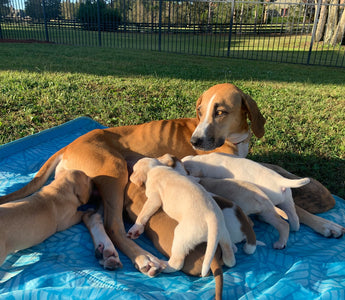I was raised in a household filled with animals. From dogs and cats to hamsters, turtles, bunnies, and birds, our home was always bustling with furry and feathery companions. Growing up in the 80s meant embracing the trend of colorful animals for Easter, knowing they'd only grace us with their presence for a short while. My mom never opted for neutering or spaying our pets, leading to a perpetual cycle of kittens and puppies roaming our house. As a child, I loved being in the company of these animals, which undoubtedly shaped my profound love for them today. I had a wonderful childhood. However, as I look back on my family's contribution to the pet population it weighs a bit heavy on my heart.
As an adult, I still love animals, but my focus is on helping them. I want to help control the pet population, not add to it. February is Spay and Neuter Awareness Month, prompting me to reflect on the history of spaying and neutering of cats and dogs. The evolution of spaying and neutering spans millennia, witnessing significant changes in practices and attitudes. Here's a brief overview:
Ancient Practices:
-
The practice of altering animals to control reproduction likely dates back to ancient civilizations, where people domesticated cats and dogs for various purposes, including companionship, hunting, and pest control.
-
Historical evidence suggests that ancient societies in Egypt, Greece, and Rome may have practiced forms of castration to control the behavior and reproduction of dogs and other animals.
Middle Ages and Renaissance:
-
During the Middle Ages and Renaissance periods, spaying and neutering techniques were used primarily for livestock, such as cattle, horses, and sheep, to improve behavior and prevent unplanned breeding.
-
The procedures were often crude and performed without the benefit of modern anesthesia or surgical techniques.
19th Century:
-
In the 19th century, as urbanization increased and people began keeping more pets in cities, concerns about overpopulation and stray animals grew.
-
Spaying and neutering started to become more common as a means of controlling the population of stray dogs and cats in urban areas.
-
In 1893 “A Veterinary Surgeon” in the anonymous Diseases of Dogs and Cats, described neutering a male cat by rolling it in a blanket and carrying out the operation without anesthetic such as chloroform or ether. An owner could insist on anesthetics of chloroform or cocaine at additional cost. Cocaine?! WOW, we have definitely made progress!
20th Century :
-
1929-1933
-
Records at the American Society for the Prevention of Cruelty to Animals (ASPCA) in New York show a peak of over 300,000 stray animals per year. This was believed to have reflected the displacement and upheaval that occurred during the Great Depression.
-
Late 1960-1970s
-
The first low-cost spay-neutering clinic opens in Los Angeles with a four month waiting list of people wanting to get their pets altered.
-
Celebrities such as Doris Day, Betty White, and Bob Barker became well known animal activists. Doris Day started her own non-profit, the Doris Day Pet Foundation. Betty White created the 1970s TV series “The Pet Set”, and we all remember Bob Barker from the Price Is Right.
-
Veterinarians began advocating for the routine spaying and neutering of pets to prevent unwanted litters and reduce the burden on animal shelters and rescue organizations.
-
1980-2000
-
More and more programs were popping up in hopes of controlling the pet population. Communities were beginning to acquire funding to help spread the word and spay and neutering was becoming more popular. Cats and dogs were becoming part of the family.
21st century:
-
By the turn of the 21st century spaying and neutering became standard practice for pet owners worldwide.
-
Animal welfare organizations, veterinary associations, and government agencies propelled campaigns to address pet overpopulation.
-
Today, spaying and neutering are widely accepted as important components of pet health care and population control efforts.
We have made a ton of progress over the years. The number of animals euthanized each year has decreased dramatically over the past four decades, from some 20 million in 1970 to about 3 million in 2011. Which is fantastic but we still have more work to do. The ASPCA estimates more than 920,000 shelter animals are still being euthanized each year.
While the number of dogs and cats being euthanized has decreased over the decades, there remains a collective responsibility to advocate for spaying and neutering as crucial components of pet health and population management.
The decision to spay and neuter your pets is incredibly significant, encompassing various considerations. Over the course of this month, I'll delve into the topic, offering insights into the pros and cons, and much more. I trust you found the history of spaying and neutering intriguing. My aim is to empower our readers to make well-informed decisions that benefit the entire family, including our beloved furry companions.
Sources:
Pi, Susan. 2022, Jan 31.Dog Time, Spay/Neuter Awareness Month: The History Of Spaying & Neutering Pets
Bowman Report. 2022, Jan 12. Fighting overpopulation and euthanasia: A history of spay-neuter practices in the U.S.
Mach, Andrew. 2012, February 10. Behind the big drop in euthanasia for America's dogs and cats










